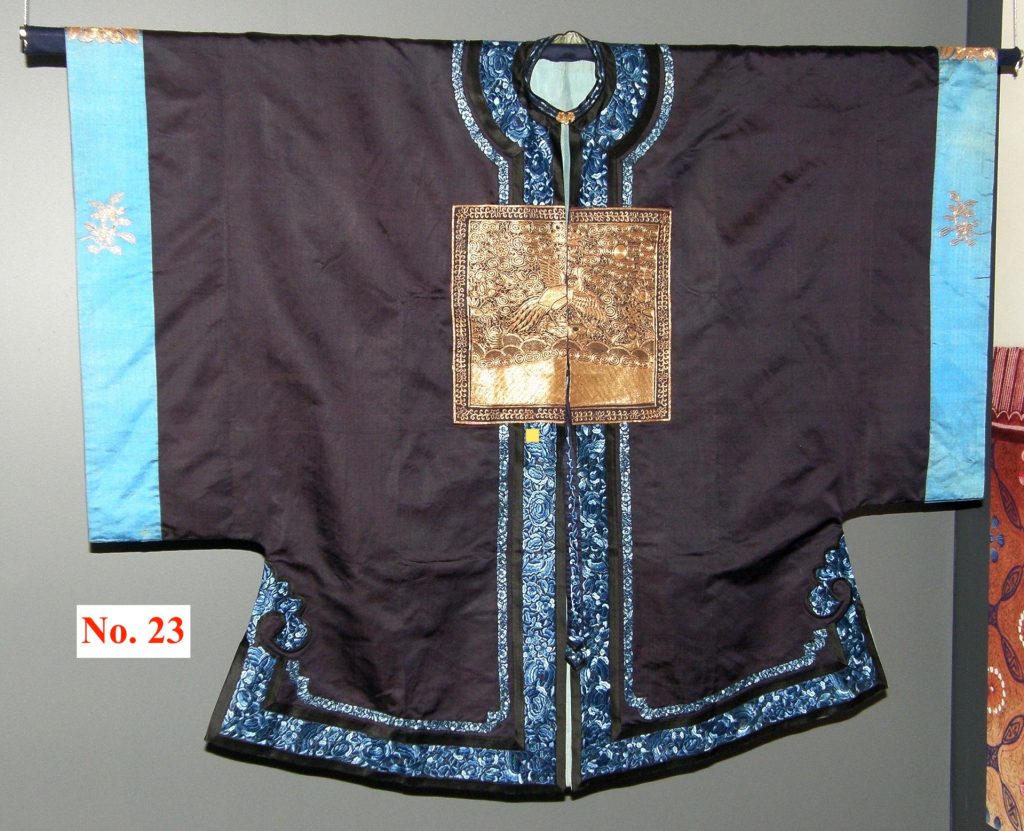
Margaret Tart was the English born wife of Quong Tart the prominent Chinese Australian merchant and well-known community member of the late 19th century (see No.5). Margaret Tart obtained this symbol of membership of the Qing Dynasty’s official ranks as the wife of Quong Tart who obtained this honour in 1888 and was promoted in 1894. His wife’s rather than Quong Tart’s Mandarin jacket can be seen on public display occasionally as his own was buried in 1903 with him in Sydney’s Rookwood Cemetery.
Quong Tart was by no means the only Chinese Australian merchant to obtain this rank in the Imperial hierarchy and in fact by the end of the 19th century it was not only extremely common but was almost a necessity for those who would do business with the Qing Empire. This was because the Qing government had by the late 19th century become aware of the wealth many Chinese people overseas had acquired and it sought to gather some of this for itself. The prestige of the Imperial officials and the necessity to pay something for this honour made for a perfect arrangement that saw Chinese merchants such as Quong Tart and Philip Lee Chun (see No.19) awarded an offical rank along with Mandarin jackets and other symbols of this status.[1]
Like the exaggerated note on the Braidwood gold medal (see No.9) the actual practical value of these official ranks is usually overstated. They conveyed prestige that would have had carried some weight locally for those travelling back to their villages of origin. But such “officials” would have had no say in the governing of the empire.
That Margaret Tart was a non-Chinese women married to a China-born man such as Quong Tart is also not as unique as it might seem at first glance. Despite the racial attitudes that prevailed throughout the 19th and well into the 20th and which were embodied in the White Australia policy (see No.1), many marriages such as the Tart’s did take place. In fact many women even travelled to their partner’s villages to live for a time and certainly many children who were the result of such marriages or the many de facto relationships also found themselves in the villages or cities of the Pearl River Delta.[2]
While the children of the Tart’s do not appear to have travelled to his village, William Lee, one of the sons of Philip Lee Chun (see No.19) was educated in Hong Kong. Similarly William Liu (see No.56) who was half Chinese was sent to his father’s village at an early age as were numerous others, some forgetting their English in the process and consequently often experiencing difficulty re-entering Australia despite their Australian birth. (See No.84)
Thus the Mandarin jacket of the English born Margaret Tart is just one symbol of a complex interlinking of Chinese Australian lives stretching over the generations, occasionally intersecting with government officials but more often taking place at the family and village level.
[1] For an excellent account of the sale of offical ranks see, James W. Hayes, Purchase of Degrees, Rank, and Appointment in Late Qing China: Some Impressions from Contemporary Sources, Journal of the Royal Asiatic Society Hong Kong Branch Vol. 53, 2013, pp.1-58.
[2] ‘Rewriting the history of Chinese families in nineteenth-century Australia’, Australian Historical Studies, vol. 42, no. 1, March 2011, pp. 62–77 by Kate Bagnall
A Note on the name Mei Quong Tart
Quong Tart is often referred to nowadays as Mei Quong Tart in a effort to provide his full name. However this only manages to mangle two Chinese languages in order to produce a name in English the man himself would no doubt have found amusing.
“Quong Tart” arises from the last two elements of the name 梅光達 with the leading character or characters being, in the Chinese style, the family name. Thus the full name of Quong Tart is Moy Quong Tart in the pronunciation in his native vernacular of 端芬 Duanfen, Taishan or Mei Guangda in the Mandarin pronunciation of those same characters.
This was even reported at the time: “My lady friends will thus be shocked to hear that for all these years they have been calling the admirable Quong Tart by his Christian name. What should they have called him? That is the question. In full, the appellation by which he would have been known in China appears to be Moy Quong Tart …”
Daily Telegraph, 12 May 1888, p.5.
The name Mei Quong Tart is thus an Australianism unknown to any Chinese language.
[The author is grateful to Ely Finch for pointing out the newspaper article.]

